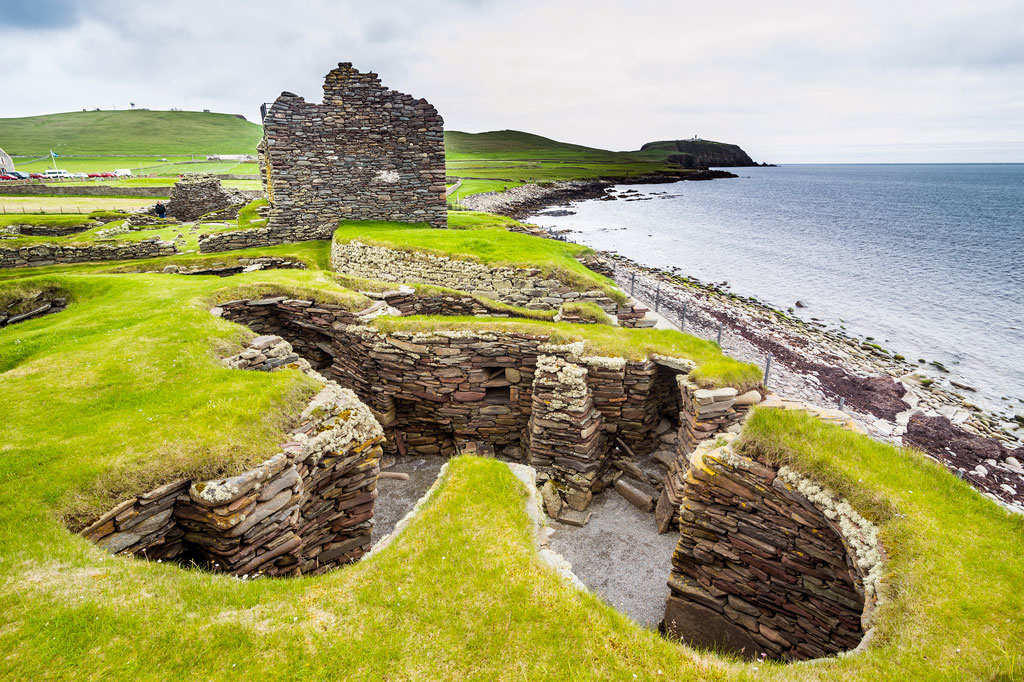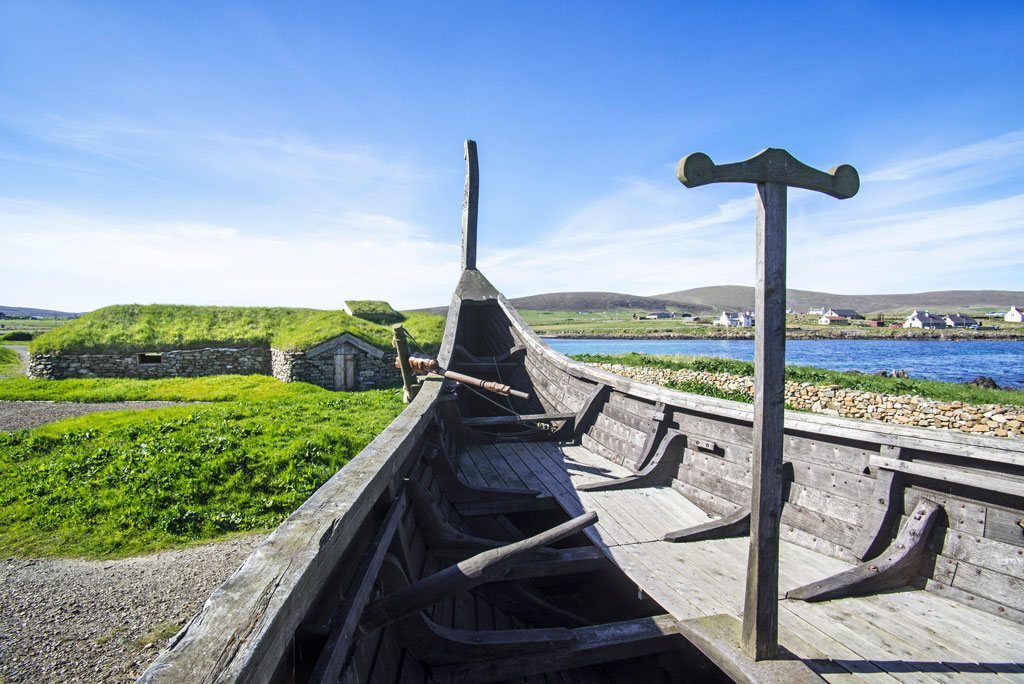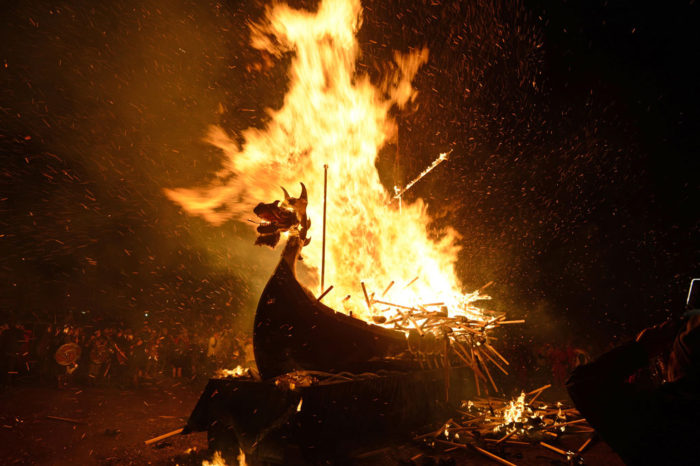Blaze of Glory: Up Helly Aa and Shetland’s history
The Up Helly Aa festival celebrates Shetland’s Viking heritage in style, yet there is far more to the remote Scottish archipelago than flaming torch parades as Janice Hopper discovers
On the last Tuesday of January the streets of Lerwick in Shetland come alive with Vikings parading down the cobblestones, blazing torches held aloft, lighting the way through
the dark streets. A vast longship is marched through the town before being set alight in a glorious inferno.
Welcome to the Up Helly Aa festival, the UK’s most northern fire festival and a pagan celebration in the midst of our deepest winter. It began in the 1880s, and each year draws thousands of locals and visitors alike to this remote archipelago for one day a year (the next festival will be on 28 January 2020). Shetland is so proud of its Norse connections that it’s possible to celebrate Viking culture, and much more besides, all year round here.
Shetland is a beguiling place. It’s experienced Pictish, Christian, Viking and Danish influences, before settling under Scottish rule in the 15th century. Fifteen of the islands are inhabited and locals often use many words in the distinctive dialect that are directly linked to old Norse.
For an overview of this remote location, the Shetland Museum and Archives in Lerwick makes a great place to start. The section on social history includes costumes and paintings from Up Helly Aa, while the archaeology display contains many Viking-era artefacts including a silver brooch from Gulberwick. There are also displays telling the stories of the islands’ rich seafaring history (from whaling to haddock fishing), hand-spun textiles, folk music traditions and more. It also houses replicas of the famous St Ninian’s Hoard – an extensive range of silverware that was buried under a church to safeguard it from Viking plunder.

Shetland’s rich history is easy to trace thanks to the islands’ enviable archaeology. Two unmissable sites are Jarlshof and Mousa Broch. The tiny, uninhabited island of Mousa (“Mossy Island” in Old Norse) is easily reached aboard a twin-engine boat. Mousa is a renowned RSPB Nature Reserve, and highlights include watching the gannets diving at speeds of up to 60 mph into the cold, northern seas to catch fish, as well as the chance to photograph the petrels nesting on the cliffs.
Then there’s the broch itself. Brochs are a distinctly Scottish building, a roundhouse or tower featuring two walls, with a spiral staircase encased in between. Mousa is the best-preserved broch in Scotland. Built around 300BC, it stands 43 feet tall and it’s still possible to climb the winding staircase to the top. The broch features twice in ancient Norse sagas; once in a tale of shipwrecked elopers, and once in a drama of abduction and attempted rescue.
At the southern tip of mainland Shetland is the remarkable Jarlshof, which reveals 4,000 years of human history in one archaeological site. As well as Norse long houses, this Historic Scotland-maintained gem, which was only uncovered in storms during the 1890s, boasts Bronze Age houses, an Iron Age broch and wheelhouses, a medieval farmstead, and a 16th-century laird’s house. While Vikings settled in Jarlshof in the 9th century, fragments from the earliest dwellings on the site date from around 2700 BC. It is rare to see layer upon layer of social history so clearly and so tangibly.
Another key attraction in the area is Sumburgh Head, home to a lighthouse, visitor centre and nature reserve. The views from the tearoom stretch out to sea, beyond the wild cliffs and into seemingly endless skies. It’s also an excellent spot to watch puffins, guillemots, razorbills and more in their natural habitat, complemented by a Marine Life Centre spanning two floors. Here one can learn about the lighthouse itself, which was designed by famed engineer Robert Stevenson and has remained in continuous use since it was first built in 1821, while also discovering the humble and isolated life of a lighthouse keeper prior to automation in 1991. Today it’s possible to book five-star, self-catering accommodation in the restored lighthouse keeper’s cottage.
Shetland’s location made it an important base for Britain’s Royal Navy and Royal Air Force, and Sumburgh Head’s radar hut offers a ‘sliding doors’ moment in Second World War history. On 8 April 1940, sub-lieutenant George Clifford Evans picked up a large-scale Luftwaffe attack targeting the British Home Fleet anchored at Scapa Flow. Evans notified the Navy, giving them 25 minutes’ warning of the imminent assault and saving the Allies from a potential tide-turning loss.
The views from Sumburgh Head are transfixing, yet Shetland has many islands to explore, each with their own unique identity. For those in pursuit of Viking heritage, the small island of Unst comes top of the list.

Despite covering an area of just 46 square miles, Unst has the highest density of rural Viking houses anywhere in the world. Sixty longhouses have been uncovered so far, including three major sites in Belmont, Hamar and Underhoull. To gain a deeper understanding of how the Vikings lived, a replica longhouse has been built at Haroldswick using traditional building techniques. This settlement is also home to the ‘Skidbladner’, a full-size replica of a 9th-century ship known as Gokstad, which was found in a Norwegian burial mound in 1880. Haroldswick also attracts visitors to its Heritage Centre, which specialises in local history and agriculture, and its Boat Haven, which houses a number of fishing vessels.
Other islands to consider visiting include Fetlar, which is home to one of Britain’s rarest breeding birds, the red-necked phalarope. The Isle of Whalsay inspired some of the great Scottish poet Hugh MacDiarmid’s finest work. And Fair Isle, the furthest south of the Shetland islands, is owned by the National Trust for Scotland and renowned for its knitwear.
Fair Isle knitting is now a term used the world over, yet it refers to the double-layered yarns and colourful geometric patterns that have characterised the work of locally produced jumpers, scarves and more for several centuries. Steps have been taken to protect the local textile industry and so the only genuine Fair Isle knitwear is created by the small Fair Isle Crafts co-operative, which uses hand-frame machines and labels quality-controlled garments with the Fair Isle trademark.

To gain greater insight into Fair Isle tradition, drop by the small Shetland Textile Museum in Lerwick. Exhibits chart the history of local tweed and lace, knitting and spinning demonstrations take place, and visitors can ask practical questions about the creative process.
One final tip, on an archipelago boasting almost 1,700 miles of coastline, is to hit the beach. Award-winning spots include Tresta on Fetlar, West Sandwick and Sands of Breckon on Yell, and West Voe and St Ninian on Shetland. Standing on the unspoiled beaches, with turquoise waters and miles of fine white sand stretching out in the blustery sunshine, it’s clear that Shetland is a land of contrasts. A land of water and fishing yet fire and festivals, peace and isolation yet Viking invasion and hidden treasure. Embrace both the Norse and Scottish. Embrace Shetland.




